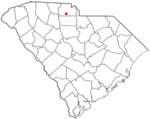Brattonsville Historic District
Buildings and structures in York County, South CarolinaGeorgian architecture in South CarolinaHistoric districts on the National Register of Historic Places in South CarolinaMidlands South Carolina Registered Historic Place stubsMuseums in York County, South Carolina ... and 4 more
NRHP infobox with nocatNational Register of Historic Places in York County, South CarolinaOpen-air museums in South CarolinaUse mdy dates from August 2023

The Brattonsville Historic District is a historic district and unincorporated community in York County, South Carolina. It includes three homes built between 1776 and 1855 by the Brattons, a prominent family of York County. It was named to the National Register of Historic Places in 1971.
Excerpt from the Wikipedia article Brattonsville Historic District (License: CC BY-SA 3.0, Authors, Images).Brattonsville Historic District
Brattonsville Road,
Geographical coordinates (GPS) Address Nearby Places Show on map
Geographical coordinates (GPS)
| Latitude | Longitude |
|---|---|
| N 34.867777777778 ° | E -81.1775 ° |
Address
Brattonsville Road (State Route 165;State Road S-46-165)
Brattonsville Road
29726
South Carolina, United States
Open on Google Maps





